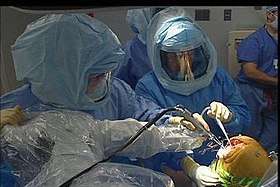MAKOplasty
| MAKOplasty | |
|---|---|
 Surgeon performing a procedure | |
| Specialty | orthopedic |
MAKOplasty is a surgical procedure for partial knee or total hip arthroplasty using a RIO Robotic Arm Interactive Orthopedic System developed by MAKO Surgical Corp. RIO is cleared by the FDA for use in surgical knee and hip procedures, in which the use of stereotactic surgery may be appropriate, and where reference to rigid anatomical bony structures can be identified relative to a CT-based model of anatomy.[1]
Procedure
MAKOplasty is used to enable surgeons to plan and perform partial knee, total knee or total hip replacement procedures by using three-dimensional computer imaging based on a CT scan.[2] This allows them to determine optimal implant size, position, and alignment for each individual patient, and to map out accurately the areas of bone they want to remove. During surgery, the robotic arm system provides visual, auditory, and tactile control to help assure that surgeons cut away only the bone planned to be resected prior to surgery. The procedure is said to take the guesswork out of surgery, resulting in accurate and reproducible results.[2]
For partial-knee replacements, MAKOplasty allows surgeons to remove only the diseased portions of the joint, preserving healthy tissue and ligaments, resulting in a more natural feeling knee. The procedure can be performed on the medial compartment, the lateral compartment, the patello-femoral compartment or on a combination of the medial and the patello-femoral compartments of the knee. Patients with bicompartmental MAKOplasty have improved function over those with total knee replacement surgery, and demonstrate better post-operative range of motion and quadriceps strength compared to total knee arthroplasty.[3]
Interim results from a survivorship study indicate that implants placed with the robotic arm technology have a 0.4% failure rate two years after surgery, compared to 4% of implants placed manually.[4] According to a randomized controlled trial, MAKOplasty patients experience less pain during the first week after surgery than do patients who underwent manual surgery after two months. The same study also concluded that MAKOplasty unicompartmental knee arthroplasty is more accurate than manual unicompartmental knee arthroplasty.[5] A different study reported that MAKOplasty is two-to-three times more accurate than manual techniques for partial knee implant placement.[6]
For total hip replacement, MAKOplasty increases accuracy of implant placement into the socket, which reduces potential for impingement, implant wear and dislocation.[7] A study reported that MAKOplasty is four-to-six times more accurate than manual techniques for implant placement.[8] Results from a multicenter trial indicate that 84% of implants placed with MAKOplasty robotic arm technology are in an acceptable range, compared to only 47% of implants placed manually.[9]
See also
References
- ↑ Conditt MA, Roche MW (February 2009). "Minimally invasive robotic-arm-guided unicompartmental knee arthroplasty". The Journal of Bone and Joint Surgery. American Volume. 91 Suppl 1: 63–8. doi:10.2106/JBJS.H.01372. PMID 19182027.
- 1 2 Doyle, Karen (March 2012). "MAKOplasty Improves Surgical Precision and Patient Outcomes at Quincy Medical Center". MD News. pp. 6–8.
- ↑ Conditt, Michael; Kreuzer, Stefan; Jones, Jennifer; Dalal, Sam (October 3–6, 2012). "Functional Recovery After Bicompartmental Arthroplasty, Navigated TKA and Traditional TKA". The Bone and Joint Journal.
- ↑ Roche, MW; Coon, T.; Pearle, AD; Dounchis, J. (October 3–6, 2012). Two Year Survivorship of Robotically Guided medical MCK Onlay. 25th Annual Congress of ISTA. Sydney, Australia.
- ↑ Blyth, M.J.; Smith, J.; Jones, B.; MacLean III, AB; Rowe, P. (March 2013). Does Robotic Surgical Assistance Improve The Accuracy Of Implant Placement In Unicompartmental Knee Arthroplasty. AAOS 2013 Annual Meeting. Chicago, IL.
- ↑ Dunbar NJ, Roche MW, Park BH, Branch SH, Conditt MA, Banks SA (May 2012). "Accuracy of dynamic tactile-guided unicompartmental knee arthroplasty". The Journal of Arthroplasty. 27 (5): 803–8.e1. doi:10.1016/j.arth.2011.09.021. PMID 22088782.
- ↑ Harshman, Marissa (23 May 2011). "Cutting-Edge Operation". The Columbian. HighBeam. Retrieved 18 February 2013.
- ↑ Nawabi DH, Conditt MA, Ranawat AS, et al. (March 2013). "Haptically guided robotic technology in total hip arthroplasty: a cadaveric investigation". Proceedings of the Institution of Mechanical Engineers, Part H: Journal of Engineering in Medicine. 227 (3): 302–9. PMID 23662346.
- ↑ Domb, M.D., Benjamin (23 August 2012). "Questions To Ask Your Doctor Before Getting A Hip Replacement". The Doings. HighBeam. Retrieved 18 February 2013.